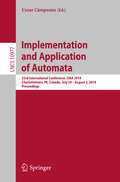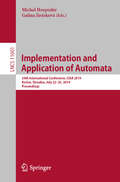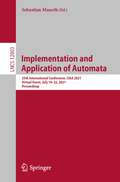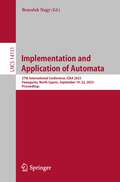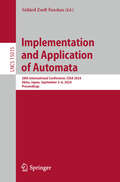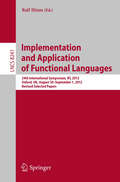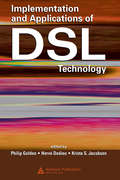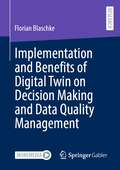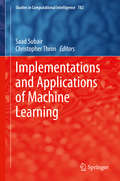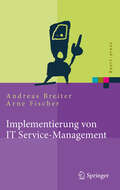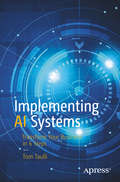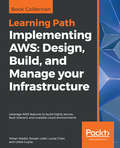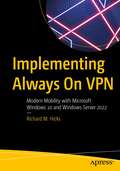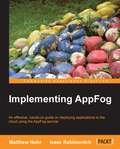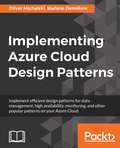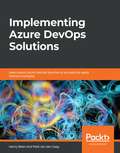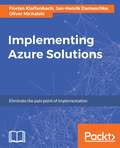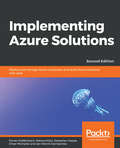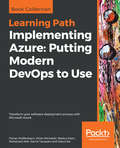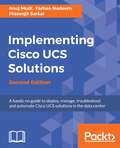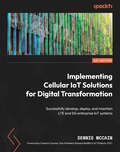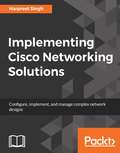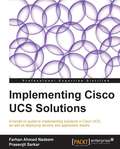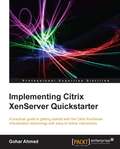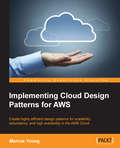- Table View
- List View
Implementation and Application of Automata: 23rd International Conference, CIAA 2018, Charlottetown, PE, Canada, July 30 – August 2, 2018, Proceedings (Lecture Notes in Computer Science #10977)
by Cezar CâmpeanuThis book constitutes the proceedings of the 23rd International Conference on Implementation and Application of Automata, CIAA 2018, held in Charlottetown, PE, Canada, in July/August 2018.The 23 regular papers presented in this book together with 4 invited papers were carefully reviewed and selected from 39 initial submissions. The topics of the papers include state complexity of automata, implementations of automata and experiments, enhanced regular expressions, and complexity analysis.
Implementation and Application of Automata: 24th International Conference, CIAA 2019, Košice, Slovakia, July 22–25, 2019, Proceedings (Lecture Notes in Computer Science #11601)
by Michal Hospodár Galina JiráskováThis book constitutes the proceedings of the 24th International Conference on Implementation and Application of Automata, CIAA 2019, held in Kosice, Slovakia, in July 2019.The 17 regular papers presented together with 2 invited papers in this book were carefully reviewed and selected from 29 initial submissions. The topics of the papers include complexity of languages and language operations, regular expressions, picture languages, jumping automata, input driven and two-dimensional automata, tree languages and tree transducers, architecture of oritatami systems, intruder deduction problem, context sensitive ash codes, rational relations, and algorithms for manipulating sequence binary decision diagrams
Implementation and Application of Automata: 25th International Conference, CIAA 2021, Virtual Event, July 19-22, 2021, Proceedings (Lecture Notes in Computer Science #12803)
by Sebastian ManethThis book constitutes the proceedings of the 25th International Conference on Implementation and Application of Automata, CIAA 2021, held in July 2021. Due to Covid-19 pandemic the conference was held virtually. The 13 regular papers presented in this book were carefully reviewed and selected from 20 submissions. The topics of the papers cover various fields in the application, implementation, and theory of automata and related structures.
Implementation and Application of Automata: 27th International Conference, CIAA 2023, Famagusta, North Cyprus, September 19–22, 2023, Proceedings (Lecture Notes in Computer Science #14151)
by Benedek NagyThis book constitutes the proceedings of the 27th International Conference on Implementation and Application of Automata, CIAA 2023, held in Famagusta, North Cyprus, during September 19–22, 2023. The 20 regular papers presented in this book together with invited talks were carefully reviewed and selected from 30 submissions. The topics of the papers cover various fields in the application, implementation, and theory of automata and related structures.
Implementation and Application of Automata: 28th International Conference, CIAA 2024, Akita, Japan, September 3–6, 2024, Proceedings (Lecture Notes in Computer Science #15015)
by Szilárd Zsolt FazekasThis book constitutes the proceedings of the 28th International Conference on Implementation and Application of Automata, CIAA 2024, held in Akita, Japan, during September 3-6, 2024. The 24 full papers and one invited paper presented here were carefully reviewed and selected from 38 submissions. These papers have been covering various fields in the application, implementation, and theory of automata and related structures.
Implementation and Application of Functional Languages
by Ralf HinzeThis book contains the selected peer-reviewed and revised papers from the 24th International Symposium on Implementation and Application of Functional Languages, IFL 2012, held in Oxford, UK, in August/September 2012. The 14 papers included in this volume were carefully reviewed and selected from 28 revised submissions received from originally 37 presentations at the conference. The papers relate to the implementation and application of functional languages and function-based programming.
Implementation and Applications of DSL Technology
by Hervé Dedieu Krista S. Jacobsen Philip GoldenThe digital subscriber line (DSL) industry is expanding rapidly and a technology once thought to be only transitional will soon clear $100 billion in total annual service revenue. From the world's leading DSL experts, Implementation and Application of DSL Technologies builds upon the theory presented in Fundamentals of DSL Technologies
Implementation and Benefits of Digital Twin on Decision Making and Data Quality Management
by Florian BlaschkeDigital twin technology is becoming important for the realization of Industry 4.0 using cyber-physical systems (CPS) and information technology. CPS form the backbone to support the creation of a network for decentralized and autonomous decision-making. The design principles for Industry 4.0 serve as guidelines for virtualization concepts that are virtual copies of the physical world and create a link between the real and virtual worlds to collect data and monitor processes, the so-called digital twin. In this book, a theoretical digital twin-driven decision-making model has been developed that combines corporate data quality management, a process digital twin, and a model-driven decision support system. It leverages the benefits of the digital twin to create, test and build a process in the virtual world that supports decision making by combining data, analytics and visualization of insights to help managers make better decisions
Implementations and Applications of Machine Learning (Studies in Computational Intelligence #782)
by Saad Subair Christopher ThronThis book provides step-by-step explanations of successful implementations and practical applications of machine learning. The book’s GitHub page contains software codes to assist readers in adapting materials and methods for their own use. A wide variety of applications are discussed, including wireless mesh network and power systems optimization; computer vision; image and facial recognition; protein prediction; data mining; and data discovery. Numerous state-of-the-art machine learning techniques are employed (with detailed explanations), including biologically-inspired optimization (genetic and other evolutionary algorithms, swarm intelligence); Viola Jones face detection; Gaussian mixture modeling; support vector machines; deep convolutional neural networks with performance enhancement techniques (including network design, learning rate optimization, data augmentation, transfer learning); spiking neural networks and timing dependent plasticity; frequent itemset mining; binary classification; and dynamic programming. This book provides valuable information on effective, cutting-edge techniques, and approaches for students, researchers, practitioners, and teachers in the field of machine learning.
Implementierung von IT Service-Management
by Arne Fischer Andreas BreiterBisher wurde das IT Service-Management in der öffentlichen Verwaltung in Deutschland nur am Rande behandelt. In diesem Buch geben die Autoren einen umfassenden Einblick in die bisherigen Fortschritte bei der Implementierung von IT-Prozessen in öffentlichen Einrichtungen und arbeiten, basierend auf fünf Fallstudien, Erfolgsfaktoren heraus, die auch auf andere Organisationen übertragbar sind. Bei der Aufbereitung der Erfolgsfaktoren liegt der Schwerpunkt bei den organisatorischen Maßnahmen zur Prozess-, Kunden- und Dienstleistungsorientierung.
Implementing AI Systems: Transform Your Business in 6 Steps
by Tom TaulliAI is one of the fastest growing corners of the tech world. But there remains one big problem: many AI projects fail. The fact is that AI is unique among IT projects. The technology requires a different mindset, in terms of understanding probabilities, data structures and complex algorithms. There is also a need to deal with complex issues like ethics and privacy.This is where Implementing AI Systems comes in. You'll learn the step-by-step process for successful implementations of AI, backed up with numerous case studies from top companies. This book puts everything you need to know into one place – that is, it’s the handbook you need for AI. You’ll focus primarily on understanding the core concepts for AI like NLP, Machine Learning, Deep Learning and so on.This book will help you find the right areas to apply AI.What You’ll LearnPut together an effective data strategyCreate models and how to successfully test themEvaluate AI toolsAssemble the right teamScale AI across an organizationWho This Book Is ForPrimarily for managers, IT professionals and executives of mid-size and large companies wanting to implement AI in their organization.
Implementing AWS: Leverage AWS features to build highly secure, fault-tolerant, and scalable cloud environments
by Yohan Wadia Lucas Chan Rowan Udell Udita GuptaWork through exciting recipes to administer your AWS cloud Key Features Build secure environments using AWS components and services Explore core AWS features with real-world applications and best practices Design and build Lambda functions using real-world examples Book Description With this Learning Path, you'll explore techniques to easily manage applications on the AWS cloud. You'll begin with an introduction to serverless computing, its advantages, and the fundamentals of AWS. The following chapters will guide you on how to manage multiple accounts by setting up consolidated billing, enhancing your application delivery skills, with the latest AWS services such as CodeCommit, CodeDeploy, and CodePipeline to provide continuous delivery and deployment, while also securing and monitoring your environment's workflow. It'll also add to your understanding of the services AWS Lambda provides to developers. To refine your skills further, it demonstrates how to design, write, test, monitor, and troubleshoot Lambda functions. By the end of this Learning Path, you'll be able to create a highly secure, fault-tolerant, and scalable environment for your applications. This Learning Path includes content from the following Packt products: AWS Administration: The Definitive Guide, Second Edition by Yohan Wadia AWS Administration Cookbook by Rowan Udell, Lucas Chan Mastering AWS Lambda by Yohan Wadia, Udita Gupta What you will learn Explore the benefits of serverless computing and applications Deploy apps with AWS Elastic Beanstalk and Amazon Elastic File System Secure environments with AWS CloudTrail, AWSConfig, and AWS Shield Run big data analytics with Amazon EMR and Amazon Redshift Back up and safeguard data using AWS Data Pipeline Create monitoring and alerting dashboards using CloudWatch Effectively monitor and troubleshoot serverless applications with AWS Design serverless apps via AWS Lambda, DynamoDB, and API Gateway Who this book is for This Learning Path is specifically designed for IT system and network administrators, AWS architects, and DevOps engineers who want to effectively implement AWS in their organization and easily manage daily activities. Familiarity with Linux, web services, cloud computing platforms, virtualization, networking, and other administration-related tasks will assist in understanding the concepts in the book. Prior hands-on experience with AWS core services such as EC2, IAM, S3, and programming languages, such as Node.Js, Java, and C#, will also prove beneficial.
Implementing Always On VPN: Modern Mobility with Microsoft Windows 10 and Windows Server 2022
by Richard M. HicksImplement and support Windows 10 Always On VPN, the successor to Microsoft's popular DirectAccess. This book teaches you everything you need to know to test and adopt the technology at your organization that is widely deployed around the world.The book starts with an introduction to Always On VPN and discusses fundamental concepts and use cases to compare and contrast it with DirectAccess. You will learn the prerequisites required for implementation and deployment scenarios. The book presents the details of recommended VPN protocols, client IP address assignment, and firewall requirements. Also covered is how to configure Routing and Remote Access Service (RRAS) along with security and performance optimizations. The Configuration Service Provider (CSP) is discussed, and you will go through provisioning Always On VPN to Windows 10 clients using PowerShell and XML as well as Microsoft Intune. Details about advanced client configuration and integration with Azure security services are included. You will know how to implement Always On VPN infrastructure in a redundant and highly available (HA) configuration, and guidance for ongoing system maintenance and operational support for the VPN and NPS infrastructure is provided. And you will know how to diagnose and troubleshoot common issues with Always On VPN.After reading this book, you will be able to plan, design, and implement a Windows 10 Always On VPN solution to meet your specific requirements.What Will You LearnPrepare your infrastructure to support Windows 10 Always On VPN on premises or in the cloudProvision and manage Always On VPN clients using modern management methods such as IntuneUnderstand advanced integration concepts for extending functionality with Microsoft AzureTroubleshoot and resolve common configuration and operational errors for your VPNWho This Book Is ForIT professionals and technology administrators for organizations of all sizes
Implementing AppFog
by Matthew Nohr Isaac RabinovitchThis book is a practical, hands-on guide to implementing and deploying apps on the AppFog platform.Implementing AppFog is for developers who want to be able to upload applications to the cloud, and for implementation specialists, who implement and deploy apps on the AppFog platform. It is best to have Ruby installed, but we will walk you through the installation process if you do not already have it. It would be ideal to have some knowledge of cloud computing and know about the basics of database and network deployment.
Implementing Azure Cloud Design Patterns: Implement efficient design patterns for data management, high availability, monitoring and other popular patterns on your Azure Cloud
by Stefano Demiliani Oliver MichalskiA hands-on guide to mastering Azure cloud design patterns and best practices. Key Features Master architectural design patterns in Azure. Get hands-on with implementing design patterns. Implement best practices for improving efficiency and security Book Description A well designed cloud infrastructure covers factors such as consistency, maintenance, simplified administration and development, and reusability. Hence it is important to choose the right architectural pattern as it has a huge impact on the quality of cloud-hosted services. This book covers all Azure design patterns and functionalities to help you build your cloud infrastructure so it fits your system requirements. This book initially covers design patterns that are focused on factors such as availability and data management/monitoring. Then the focus shifts to complex design patterns such as multitasking, improving scalability, valet keys, and so on, with practical use cases. The book also supplies best practices to improve the security and performance of your cloud. By the end of this book, you will thoroughly be familiar with the different design and architectural patterns available with Windows Azure and capable of choosing the best pattern for your system. What you will learn Learn to organize Azure access Design the core areas of the Azure Execution Model Work with storage and data management Create a health endpoint monitoring pattern Automate early detection of anomalies Identify and secure Azure features Who this book is for This book is targeted at cloud architects and cloud solution providers who are looking for an extensive guide to implementing different patterns for the deployment and maintenance of services in Microsoft Azure. Prior experience with Azure is required as the book is completely focused on design patterns.
Implementing Azure DevOps Solutions: Learn about Azure DevOps Services to successfully apply DevOps strategies
by Henry Been Maik Van GaagThis book targets software developers and operations specialists interested in implementing DevOps practices for the Azure cloud. Application developers and IT professionals with some experience in software development and development practices would find this book useful. Some familiarity with basic usage of Azure DevOps is an added advantage.
Implementing Azure Solutions: Deploy And Manage Azure Containers And Build Azure Solutions With Ease, 2nd Edition
by Florian Klaffenbach Jan-Henrik Damaschke Oliver MichalskiA practical guide that enhances your skills in implementing Azure solutions for your organization About This Book • Confidently configure, deploy, and manage cloud services and virtual machines • Implement a highly-secured environment and respond to threats with increased visibility • This comprehensive guide is packed with exciting practical scenarios that enable you to implement Azure solutions with ease Who This Book Is For This book is for IT architects, system and network admins, and DevOps engineers who are aware of Azure solutions and want to implement them for their organization. What You Will Learn • Implement virtual networks, network gateways, Site-to-Site VPN, ExpressRoute, routing, and network devices • Understand the working of different storage accounts in Azure • Plan, deploy, and secure virtual machines • Deploy and manage Azure Containers • Get familiar with some common Azure usage scenarios In Detail Microsoft Azure has numerous effective solutions that shape the future of any business. However, the major challenge that architects and administrators face are implementing these solutions appropriately. Our book focuses on various implementation scenarios that will help overcome the challenge of implementing Azure's solutions in a very efficient manner and will also help you to prepare for Microsoft Architect exam. You will not only learn how to secure a newly deployed Azure Active Directory but also get to know how Azure Active Directory Synchronization could be implemented. To maintain an isolated and secure environment so that you can run your virtual machines and applications, you will implement Azure networking services. Also to manage, access, and secure your confidential data, you will implement storage solutions. Toward the end, you will explore tips and tricks to secure your environment. By the end, you will be able to implement Azure solutions such as networking, storage, and cloud effectively. Style and approach This step-by-step guide focuses on implementing various Azure solutions for your organization. The motive is to provide a comprehensive exposure and ensure they can implement these solutions with ease.
Implementing Azure Solutions: Deploy and manage Azure containers and build Azure solutions with ease, 2nd Edition
by Florian Klaffenbach Jan-Henrik Damaschke Oliver Michalski Markus Klein Sebastian HoppeGet up and running with Azure services and learn how to implement them in your organizationKey FeaturesDeploy Azure Services in a controlled and preconfigured environmentDiscover best practices and techniques for implementing Azure SolutionsBuild and deploy an app using Azure App ServicesBook DescriptionMicrosoft Azure offers numerous solutions that can shape the future of any business. However, the major challenge that architects and administrators face lies in implementing these solutions.Implementing Azure Solutions helps you overcome this challenge by enabling you to implement Azure Solutions effectively. The book begins by guiding you in choosing the backend structure for your solutions. You will then work with the Azure toolkit and learn how to use Azure Managed Apps to share your solutions with the Azure service catalog. The book then focuses on various implementation techniques and best practices such as implementing Azure Cloud Services by configuring, deploying, and managing cloud services. As you progress through the chapters, you’ll learn how to work with Azure-managed Kubernetes and Azure Container Services.By the end of the book, you will be able to build robust cloud solutions on Azure.What you will learnCreate and manage a Kubernetes cluster in Azure Kubernetes Service (AKS)Implement site-to-site VPN and ExpressRoute connections in your environmentExplore the best practices in building and deploying app servicesUse Telemetry to monitor your Azure SolutionsDesign an Azure IoT solution and learn how to operate in different scenariosImplement a Hybrid Azure Design using Azure StackWho this book is forIf you’re an IT architect, IT professional, or DevOps engineer who plans to implement Azure Solutions for your organization, this book is for you.
Implementing Azure: Transform your software deployment process with Microsoft Azure
by Florian Klaffenbach Oliver Michalski Namit Tanasseri Markus Klein Mohamed WaliExplore powerful Azure DevOps solutions to develop and deploy your software faster and more efficiently. Key Features Build modern microservice-based systems with Azure architecture Learn to deploy and manage cloud services and virtual machines Configure clusters with Azure Service Fabric for deployment Book Description This Learning Path helps you understand microservices architecture and leverage various services of Microsoft Azure Service Fabric to build, deploy, and maintain highly scalable enterprise-grade applications. You will learn to select an appropriate Azure backend structure for your solutions and work with its toolkit and managed apps to share your solutions with its service catalog. As you progress through the Learning Path, you will study Azure Cloud Services, Azure-managed Kubernetes, and Azure Container Services deployment techniques. To apply all that you've understood, you will build an end-to-end Azure system in scalable, decoupled tiers for an industrial bakery with three business domains. Toward the end of this Learning Path, you will build another scalable architecture using Azure Service Bus topics to send orders between decoupled business domains with scalable worker roles processing these orders. By the end of this Learning Path, you will be comfortable in using development, deployment, and maintenance processes to build robust cloud solutions on Azure. This Learning Path includes content from the following Packt products: Learn Microsoft Azure by Mohamed Wali Implementing Azure Solutions - Second Edition by Florian Klaffenbach, Oliver Michalski, Markus Klein Microservices with Azure by Namit Tanasseri and Rahul Rai What you will learn Study various Azure Service Fabric application programming models Create and manage a Kubernetes cluster in Azure Kubernetes Service Use site-to-site VPN and ExpressRoute connections in your environment Design an Azure IoT app and learn to operate it in various scenarios Implement a hybrid Azure design using Azure Stack Build Azure SQL databases with Code First Migrations Integrate client applications with Web API and SignalR on Azure Implement the Azure Active Directory (Azure AD) across the entire system Who this book is for If you are an IT system architect, network admin, or a DevOps engineer who wants to implement Azure solutions for your organization, this Learning Path is for you. Basic knowledge of the Azure Cloud platform will be beneficial.
Implementing CISCO UCS Solutions - Second Edition
by Anuj ModiThis book is for system, network, and storage administrators who are responsible for Cisco UCS deployments. You need to have basic knowledge of server architecture, network, and storage technologies.
Implementing Cellular IoT Solutions for Digital Transformation: Successfully develop, deploy, and maintain LTE and 5G enterprise IoT systems
by Dennis McCain Cameron CourseyA pragmatic handbook on IoT technologies and markets that will guide you in implementing cellular IoT solutions as part of an enterprise's digital transformation affecting both operational cost savings and new business models.Purchase of the print or Kindle book includes a free eBook in the PDF format.Key FeaturesUnderstand all the critical aspects of a cellular IoT solution with this practical guideIdentify key enterprise IoT market requirements and IoT business casesDevelop robust end-to-end cellular IoT solutions with the help of best practices and case studiesBook DescriptionEven if you're an IoT technology manager with a sound understanding of wireless local area network technologies like Wi-Fi and Bluetooth, you may face many unique challenges when implementing a wireless wide area network (WWAN) IoT solution with cellular technologies with respect to choosing the optimal IoT device, cellular connectivity, and architecture. To help you overcome such roadblocks, this digital transformation book guides you in implementing a robust, end-to-end cellular IoT solution using best practices for all aspects of managing the IoT solution.Starting with an introduction to the top IoT markets and solutions in the context of an enterprise's digital transformation, this book will show you how this leads to cost savings and new business models. You'll grasp all you need to know about the IoT system components, life cycle, and best practices for implementing an IoT solution. While the book explains all the leading IoT wireless technologies, the focus is on LTE and 5G cellular technologies. With a review of real-world cellular IoT solution case studies and future IoT trends, you'll be ready to work with wireless IoT technologies, devices, and architectures.By the end of this book, you'll be able to identify the best wireless technologies for your IoT use cases and successfully implement cellular IoT solutions addressing key issues in the solution life cycle.What you will learnUnderstand how IoT enables an enterprise's digital transformationDiscover the applications of various IoT wireless technologiesExplore IoT devices, architectures, and real-world use casesDive deep into LTE and 5G cellular technologies and how they enable IoTBuild a privacy and security framework in an IoT solutionSelect the best components for a cellular IoT enterprise solutionOvercome challenges in the IoT solution life cycleExamine new cellular IoT technologies, trends, and business modelsWho this book is forThis book is for IoT technology managers, leaders, C-suite executives, and decision-makers considering or currently developing IoT solutions based on wireless/cellular technologies such as LTE and 5G. You'll be able to make the most of this book if you understand the importance of IoT connectivity in the context of its applications.
Implementing Cisco Networking Solutions
by Harpreet SinghLearn the art of designing, implementing, and managing Cisco's networking solutions on datacenters, wirelessly, security and mobility to set up an Enterprise network. About This Book • Implement Cisco's networking solutions on datacenters and wirelessly, Cloud, Security, and Mobility • Leverage Cisco IOS to manage network infrastructures. • A practical guide that will show how to troubleshoot common issues on the network. Who This Book Is For This book is targeted at network designers and IT engineers who are involved in designing, configuring, and operating enterprise networks, and are in taking decisions to make the necessary network changes to meet newer business needs such as evaluating new technology choices, enterprise growth, and adding new services on the network. The reader is expected to have a general understanding of the fundamentals of networking, including the OSI stack and IP addressing. What You Will Learn • Understand the network lifecycle approach • Get to know what makes a good network design • Design components and technology choices at various places in the network (PINS) • Work on sample configurations for network devices in the LAN/ WAN/ DC, and the wireless domain • Get familiar with the configurations and best practices for securing the network • Explore best practices for network operations In Detail Most enterprises use Cisco networking equipment to design and implement their networks. However, some networks outperform networks in other enterprises in terms of performance and meeting new business demands, because they were designed with a visionary approach. The book starts by describing the various stages in the network lifecycle and covers the plan, build, and operate phases. It covers topics that will help network engineers capture requirements, choose the right technology, design and implement the network, and finally manage and operate the network. It divides the overall network into its constituents depending upon functionality, and describe the technologies used and the design considerations for each functional area. The areas covered include the campus wired network, wireless access network, WAN choices, datacenter technologies, and security technologies. It also discusses the need to identify business-critical applications on the network, and how to prioritize these applications by deploying QoS on the network. Each topic provides the technology choices, and the scenario, involved in choosing each technology, and provides configuration guidelines for configuring and implementing solutions in enterprise networks. Style and approach A step-by-step practical guide that ensures you implement Cisco solutions such as enterprise networks, cloud, and data centers, on small-to-large organizations.
Implementing Cisco UCS Solutions
by Prasenjit Sarkar Farhan Ahmed NadeemA tutorial-based approach which will help you understand the practical methodologies and deploying of Cisco UCS components.If you are a professional such as a system, network, or storage administrator who is responsible for Cisco UCS deployments, this is the perfect book for you. You should have some basic knowledge of the server's architecture, network, and storage technologies. Familiarity with virtualization technologies is also recommended (though not necessary) as the majority of real-world UCS deployments run virtualized loads. Knowledge of Nexus OS is not necessary as the majority of the management tasks are handled in a graphical user interface with very few exceptions using the CLI.
Implementing Citrix XenServer Quickstarter
by Gohar AhmedImplementing Citrix XenServer Quick Starter is a practical, hands-on guide that will help you get started with the Citrix XenServer Virtualization technology with easy-to-follow instructions.Implementing Citrix XenServer Quick Starter is for system administrators who have little to no information on virtualization and specifically Citrix XenServer Virtualization. If you're managing a lot of physical servers and are tired of installing, deploying, updating, and managing physical machines on a daily basis over and over again, then you should probably explore your option of XenServer Virtualization. This book will be your best friend to make you a better systems engineer.
Implementing Cloud Design Patterns for AWS
by Marcus YoungThis book is aimed at architects, solution providers, and those of the DevOps community who are looking to implement repeatable patterns for deploying and maintaining services in the Amazon cloud infrastructure. Prior experience using AWS is required as the book focuses more on the patterns and not on the basics of using AWS.
